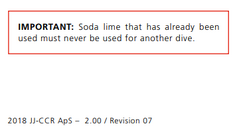And one thing that I might respectfully mention in response to the observation that many divers do exceed the manufacturer's recommendations for scrubber time.
In another thread on hypercapnea, I referred to the most important sentence in medical school: "There is a bell curve for everything". When you imply that pushing the scrubber is OK, you can't know the details of every reader's metabolism and CO2 production. While the recommendations might be conservative, they are by design. It's normalization of deviance if you promote the idea that "5 hours on a 3 hour scrubber is OK in X circumstances", because eventually that becomes a norm and people forget the "X circumstances" part of the recommendation.
It's sort of like safe PO2 levels. Yeah, you don't immediately seize if your PO2 goes to 1.61 on deco. But people can and have had ox tox events at "safe" levels. The reason why manufacturers generate standards is that they result in acceptable levels of safety for anyone using that particular stack.
I do understand that might mean wasting more sorb in warmer water. And I know that a thinking, experienced diver can consider multiple factors in making the decision about how long to use a scrubber. I would just be careful about implying that 5 is the new 3.
In another thread on hypercapnea, I referred to the most important sentence in medical school: "There is a bell curve for everything". When you imply that pushing the scrubber is OK, you can't know the details of every reader's metabolism and CO2 production. While the recommendations might be conservative, they are by design. It's normalization of deviance if you promote the idea that "5 hours on a 3 hour scrubber is OK in X circumstances", because eventually that becomes a norm and people forget the "X circumstances" part of the recommendation.
It's sort of like safe PO2 levels. Yeah, you don't immediately seize if your PO2 goes to 1.61 on deco. But people can and have had ox tox events at "safe" levels. The reason why manufacturers generate standards is that they result in acceptable levels of safety for anyone using that particular stack.
I do understand that might mean wasting more sorb in warmer water. And I know that a thinking, experienced diver can consider multiple factors in making the decision about how long to use a scrubber. I would just be careful about implying that 5 is the new 3.





